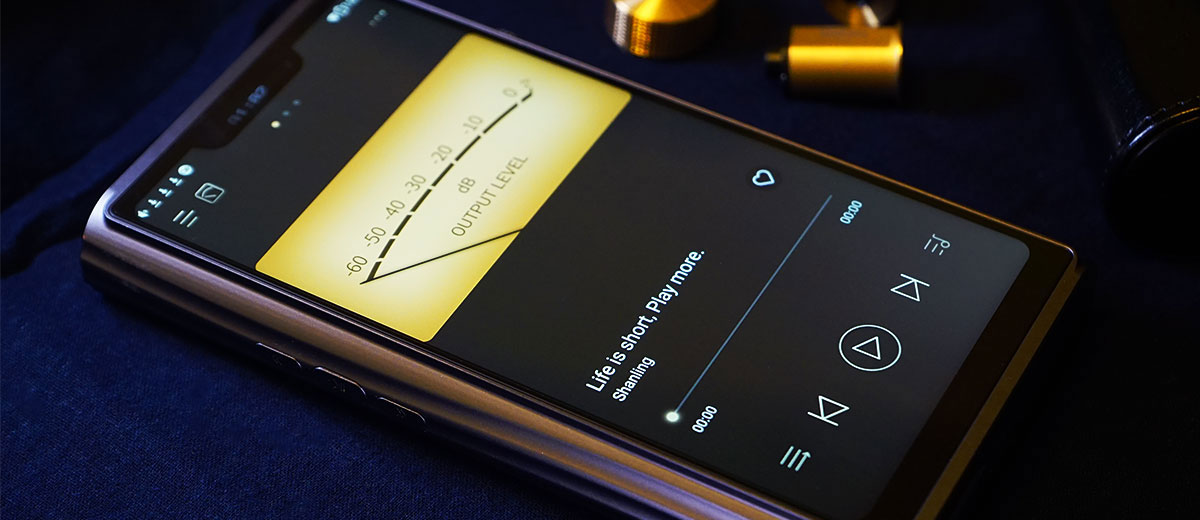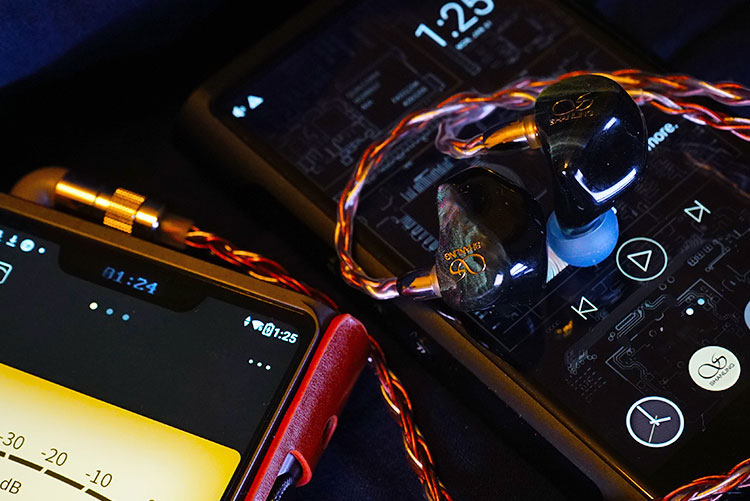Software
Android 10
With a well-supported Android 10 OS, you get a very open platform free of bloatware. The response is incredibly smooth, scrolling through the library and albums with a loading speed that is quite impressive too.
64-bit Android 10 is installed on the M9 making it is the most modern software for a Shanling device thus far. With the Qualcomm octa-core CPU and the sufficient 8GB ram, even when you open many apps and scroll all the way down, the M9 could still handle the load responsively.
Like other Shanling devices, there are software updates from time to time so users could press on the lightbulb icon to check new firmware. The latest firmware V1.4 supports the app store for international users and enhanced the Bluetooth Playback.
Performance Numbers
Running AnTuTu (v8.3.4) before installing anything on the M9, it scores an incredible 188336, and this is the highest score I have seen on a TOTL DAP so far.
This is a little bit higher than the FiiO M17‘s 181197 and marginally higher than Hiby R8‘s 187675 though arguably on par with both given an acceptable margin of error.
Looking closely at the scores break down the CPU score for M9 is slightly lower than M17 and the R8, but the memory is giving it a huge lead. In practice, fast scrolling or viewing a long list of albums is fast and smooth with 8GB RAM onboard.

Dropdown Navigation
The dropdown menu is customized to include shortcuts for gain settings, switch to headphone mode, and a dedicated, music playback optimized “Prime Mode” that force close other apps.
The default theme is dark-colored so there is a very good contrast, and you can see customized icons that are very clear and intuitive.
Shanling Music App
While you could always install other music player apps, the built-in Shanling Music App offers a smooth experience and customization for the M9 player that makes the product experience even more engaging. There is a fancy cover art view and the playback screen with an additional VU-meter display that syncs with the music accurately.
The Shanling Music App also supports Synclink control and NAS as a source. You can also Wi-Fi transfer in case you want to quickly drag an album from your laptop without over air.
In fact, there are many ways the M9 can interact with your home system, such as operating as a USB DAC, streaming over airplay, or playing songs from the NAS.
Google Play Support
For international version users, follow the steps when upgrading the firmware, and the Google app store will be enabled. You can also download other apps with the pre-installed CoolApk or APKPure applications if you have regional lock-out issues with some apps via Google.

Streaming
With 16x unfold power for MQA, the M9 is ready to stream Tidal on the go or to your home system. A Qualcomm WCN3980 wireless module is used to support 2.4/5G Wi-fi Signal and MIMO technology, which ensures a fast and stable internet connection.
The experience with music streaming apps like Tidal and Spotify is as smooth as you can imagine on Android 10, with upsampling to a max 16X working as advertised. It feels like you can’t return to smaller DAPs once you go big with the M9.
Wireless performance
WiFi Signal Detection
Both the M9 and the M8 are 5G WiFi capable. Measuring both machines 5 meters apart from my modem with one closed door in between, on the same physical spot the M9’s signal retrieval power is quite a bit stronger.
Both machines were tested to be excellent in WiFi connection speed. However, you can feel the M9 offering a better range when you try to walk away from the modem. Despite that fact, the actual experience is similar in the living room or when using a wireless IEM.

Bluetooth Range
Using my phone as a hotspot strength meter, or range finder, the signal strength with M9 and M8 were tested. The smartphone is put around 2 meters away from both the players which are placed side by side.
Using the RSSI (Received Signal Strength Indicator) both M9 and M8 are rated excellent in strength, with the M9 stronger by 7dBm when tested in another spot or over a longer range.
Sound Impressions
Summary
Out of the box with the ME800 IEMs plugged in, the M9 displays an effortlessly expansive stage and excellent clarity, utilizing a very wide and dynamic response. It sounds very spacious in staging and can accommodate a full orchestra. The virtuoso could still be heard clearly, cutting through double basses and woodwinds, also pianos in the same frequency range.
The output is impressively melodious, grand, and energetic in the highs and lows, with a strong punch in the mid-range that airily belches forward.
After a few run-in cycles together with the Shanling ME800 earphones, the low end gets even firmer in attack, and the edges in the upper mids are polished down, shaping the vocal lusher and smoother. It is no surprise the M9 sounds extremely powerful with Shanling’s dedicated amping circuitries, leaving the M8 in its dust.
Shanling is doing a fine job of quietly referencing the sound and aesthetic from the older M9, but further enhancing its accuracy, musicality, and detail treatment by one big step with this new release.
Bass
The bass on M9 is well textured, fast, and firm in attack, elaborated in the decay but without slowing the pace. The emotion and the power are terrifying when you bring on the Symphony no9 finale, The Flying Dutchman overture that has a lot of energy in its rumble.
The M9 is able to resolve and position bass elements by pinpoint accuracy without altering the presentation by overly stressing some particular frequencies. While it is a rather flat tuning, the dynamics range, as well as the low-end expansion, is excellent with a perfectly dark background even on higher-gain modes.
The bass keeps up very well with fast-shifting synthesized bass and bass guitar slaps. You can hear finger works clear and full in body, bouncy, and rich in texture. Testing with tracks that have a sudden volume jump, or Sforzando more specifically, the tension and air are well captured by M9’s fast response speed. You can feel its exquisite level of control.
Mids
It has been a long way since M0’s inception but Shanling’s DAPs have always been quite distinct in vocal reproduction. The M9 is no exemption.
The midrange tonality on M9 is unique and lush but doesn’t fall short of naturalness. In the tuning, there is a strong sense of control. Vocals, as well as other instruments across the midrange, are densely outlined, full-bodied, and precisely rounded to not take away the air and openness.
On the M9, Shanling’s vocal lushness is in full effect. There is a small hint of warmth in the sibilance zone adding to the dense, realistically weighted vocal body. That said it is not a vocal forward DAP, but the vocal is very well defined and very 3D sounding.
The M9 can accommodate strong voices with excellent vocal authority, taking away harshness and not thinning down the vocal line nor taking away the air. As such, this is an ideal pairing for IEMs like the latest Effect Audio Axiom with the “YU” module.
The textured and impactful lower midrange favors male vocal works and female singers leaning more to the upper frequencies are presented very swift and intense with decent penetrating power, sounding sweet with no sibilance.
In short, Shanling’s vocal coloring is still there, but the whole band, the whole orchestra gets into the big picture, stretching the frame wide apart with excellent definition, fast transients, and strong cohesion between elements.
Treble
When a portable device gets very powerful and fast in response, a lot of effort is needed to get the treble in control. M9’s attempt to recreate an extended, textured treble rich in harmonics and details is very successful.
Cymbals and hi-hats sound very snappy and are very precisely imaged with the transients being never clearer than before. The 5-7kHz range is very well manipulated and the frequencies beyond are carefully lifted for air.
Putting the M9 under more challenges and playing some new age music with strong treble power, violin works, and arrays of woodwinds that get very near the peaking threshold, the M9 shows off its strong versatility and dynamic range performance. It captures fine details and emotions easily but in a tranquil, facile manner.
The M9 captures the bowing speed and power, and it feels like the violinist is bowing around you and in your face when the music gets fiery.
Going from program music to more relaxing music, the M9 handles effortlessly instruments such as harmonicas and accordions in a fast-flowing and reverberating manner.
The intensity of these instruments is nicely preserved. You can hear the nuances in the output especially in some Jazz music where the vocal and backing instrument alternatively lead the stage.
Staging
The M9 can sound very expanded especially on the X-axis. While it is perceived quite deep and wide the tuning is not altered to place lead singing too far. There is good air and a subtly expressive decay as if you are in the first few rows of an opera house.
You can hear the reverb in mid-air and pick out its position without really focusing. As such, it adds to the punchiness of the instruments across the midrange frequencies.
Imaging on the M9 is easily amongst the best portable devices, clearly placed and tightly defined with excellent transients’ response. I am able to pick the vocals and instruments from any tracks at ease with edges clearly defined and no sign of compression.
Click on page 2 below for Software and Sound Impressions
Click on page 3 below for Pairings and Select Comparisons










